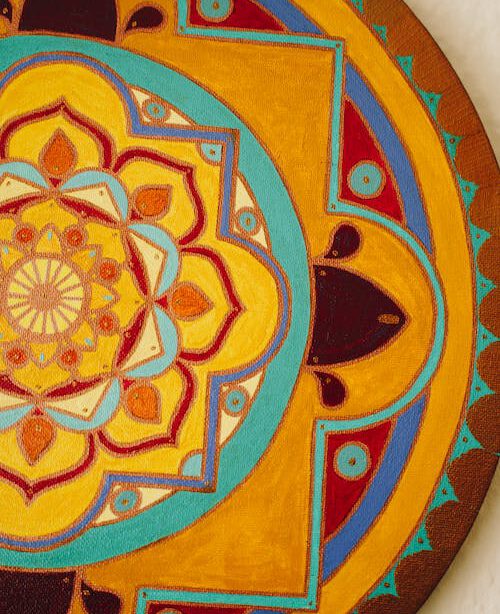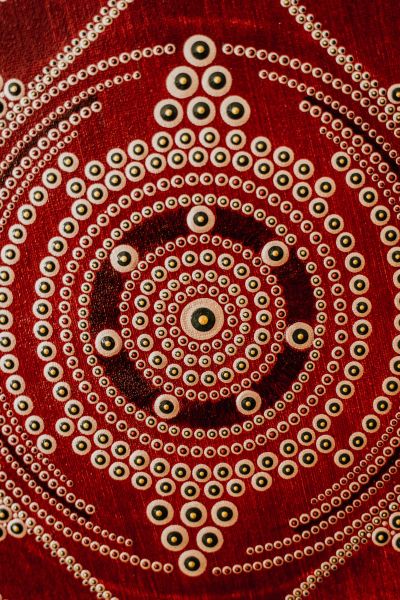Mandala meaning
The word mandala comes from the classical Indian language, Sanskrit (मण्डल). It means circle, arc, slice or disc. According to others, its meaning is also related to the mind (manas a.m. "mind").
So a mandala is more than just a simple geometric shape. In Buddhist and Hindu culture it has a powerful symbolic meaning. Mandalas are believed to represent different aspects of the universe. In China, Japan and Tibet they are most commonly used as symbols of meditation and prayer.
It can be interpreted in two different ways:
- externally, as a visual representation of the universe
- internally, in the Asian tradition, many practices such as meditation guide
In Hinduism and Buddhism, the mandala is believed to guide the believer through the process of transformation of the universe. Entering the mandala and moving towards its centre shows the way out of suffering, into joy and happiness.
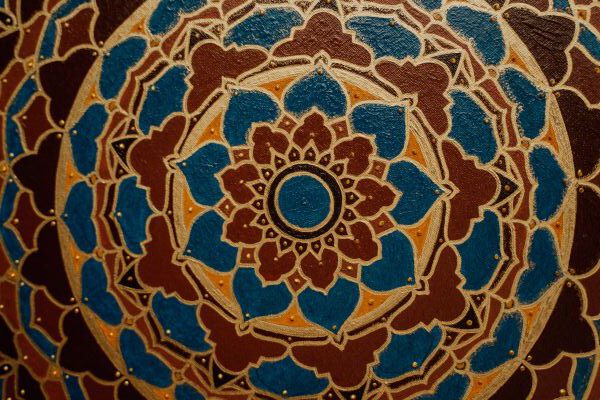
Mandala short history
The founder of Buddhism is Gautama Siddhartha. According to tradition, he was the son of Suddhodana, the king of Kapilavastu, a town near the border between northeast India and Nepal, and was born in Lumbini, in what is now Nepal. His mother tongue was the Prakrit language of Magadhi. He is believed to have lived and taught mainly in eastern India, sometime between the 6th and 4th centuries BC (the traditional account is that he lived between 563 BC and 483 BC, but more recent research puts his life slightly later). Records indicate that Gautama left his kingdom after realising human suffering. He devoted all his time to meditation and thoughtful action to attain enlightenment. He then began to preach his philosophy through India. He soon gained a devoted following and eventually founded the first Sangha, a Buddhist community of monks. His main teachings are summarised in the 'four noble truths':
- human life is essentially full of suffering (dukkha = "the unsatisfactoriness of things that causes suffering");
- the cause of this suffering is human selfishness and desire;
- there is a way to get rid of selfishness and desire;
- the so-called "noble eightfold path" leads to liberation: right contemplation, right thinking, right speech, right action, right living, right aspiration, right inquiry, right contemplation.
Over time, Buddhist monks began to promote the religion more widely. And they carried mandalas with them on their travels. This enabled the spread of these spiritual symbols throughout Asia. This is how mandalas appeared around the 4th century in Tibet, China and Japan, among other places.
So it is that, although rooted in Buddhism, mandalas soon found their way into Hinduism and other religious practices.
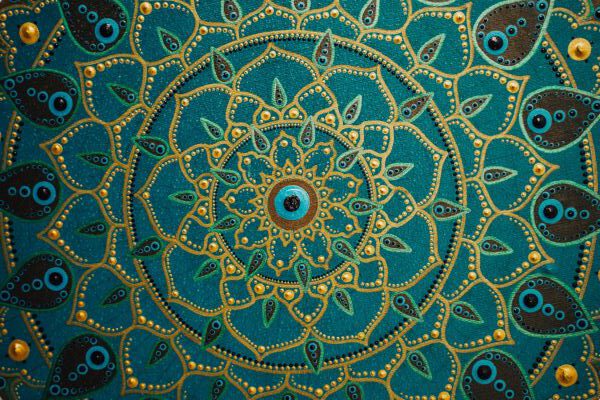
Mandala types
There are different types of mandalas in different cultures, and they are used for many different purposes, both artistic and spiritual. There are three main types of mandalas:
Teaching Mandala
The teachings of mandalas are symbolic and each shape, line and colour represents a different aspect of a philosophical or religious system. The student creates his or her own mandala following a set pattern and design principles. The resulting masterpiece is thus a visual symbol of their knowledge and learning.
Healing Mandala
Healing mandalas are more intuitive than teaching mandalas and are made for meditation. Healing mandalas are designed to promote wisdom, calm feelings and concentration. The process of making a mandala is itself a kind of meditative ritual.
Sand Mandala
Buddhist monks and Navajo cultures have long used sand mandalas as a traditional and religious element. These intricate mandala symbols made of colorful sand represent the impermanence of human life. They often take months to make, and when finished, they are swept away in a single movement.
In addition to the three main types, there are countless other mandalas: love, abundance, energy, flower, love, happiness, health or lucky mandala.
Mandala patterns
In addition to their intricate circular patterns, mandalas also contain various religious symbols. These are traditionally Buddha
represent her mind in an abstract form, which can be a wheel, a tree, a flower or jewellery.
The centre of the mandala is a point, which can be seen as a dimensionless symbol. This point is surrounded by lines and geometric patterns that symbolise the universe. This universe is encompassed by the outer circle, which represents the cyclical nature of life in the mandala.
Some common mandala symbols:
Wheel with eight spokes
The circularity of the wheel is an artistic representation of the perfect universe. The eight spokes represent the eightfold path of Buddhism, a set of practices leading to liberation and rebirth.
Bell
The bell represents the opening and emptying of the mind, allowing wisdom to flow in.
Triangle
Looking up, the triangles represent action and energy, and looking down they represent creativity and the pursuit of knowledge.
Lotus flower
A sacred symbol of Buddhism, its symmetry represents balance. Just as the lotus emerges from underwater into the light, so too can man achieve spiritual awakening and enlightenment.
Sun
A popular basis for modern mandala designs. Suns usually represent the universe, often with meanings related to life and energy.
Meaning and colours of mandalas
- White: calm, perfection, relief, compassion
- Black: insight, intuition, rebirth, secret
- Grey: love, gentleness, loyalty, spiritual healing
- Yellow: nature, receptiveness, intelligence, friendliness
- Blue: harmony, relaxation, contentment
- Fire red: change, power, love, fearlessness
- Purple: wisdom, idealism, philanthropy
- Pink: universal healing, healing of the "inner", sensitivity
- Orange: ambition, vitality, intuition, self-control
- Green: healing, trust, calm, growth, relationship
- Brown: conscious attachment to the environment, stability, closeness to the earth
- Silver: emotions, supersensory, supernatural abilities, well-being
The meaning of shapes
- Point: the "possibility", the basic unity, the point in which everything is contained, and therefore the symbol of God.
- Circlethe universe, eternity.
- Triangle: if it is at the top, it represents femininity and acceptance, if it is at the side, it represents masculine strength.
- Squareif at the top, it indicates instability, if at the side, it indicates stability.
- Star: the 6 branch refers to harmony, the 5 branch to strength.
- Waveline: symbolising the flow of life.
- Heart: brings love, love, fulfilment into our lives.
- Flower motif: a symbol of growth, life, harmony.
Use of mandala
Mandalas are used in many religious, meditation and modern contexts.
The traditional Tibetan sand mandala depicts the Buddha in his enlightened state. The patterns are made by monks on the ground. They fill small metal tubes with coloured sand and use this to form the patterns. Such a masterpiece can take weeks to complete. However, despite all the work and energy, the sand mandalas are destroyed shortly after they are made. Thus proclaiming the Buddhist belief that "nothing is permanent".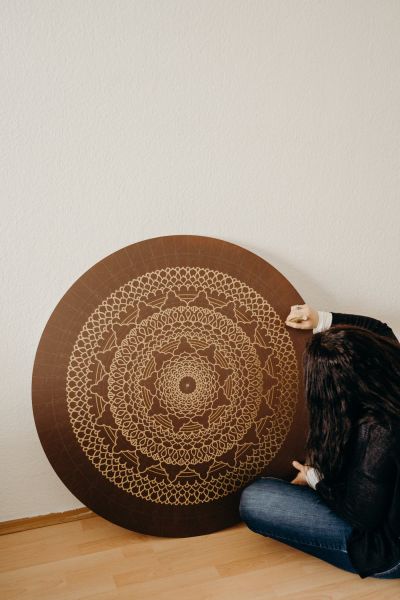
In today's modern world, the mandala appears as a symbol in countless places. Yoga mandalas, for example, also represent ancient ideals: they signify sacred space and the exclusion of external influences. Mandalas are often placed around the yoga studio and sometimes mandala drawing and colouring are part of the meditation.
Mandalas are also used in healing circles, for example for artistic purposes. In such cases, their creativity and calming presence helps to restore the body, mind and heart.
Mandalas can be found in dream catchers, which are designed to protect sleep and dreams. The round pattern, familiar geometric elements and lines are easily recognisable.
They can also be found in tattoos, colouring and modern interior design.
Jung's experiment
The Swiss psychologist C. G. Jung, while studying Eastern religions, came to the realization that mandalas could be used therapeutically in his psychological practice. In the 1920s he had his patients draw mandalas. The only instructions given to the patients were to draw something in a circle - at will. He later summarised the results of his research in Mandala - Images from the Unconscious.
Make your own mandala!
Take a blank piece of white cardboard and draw a regular circle on it. Put on some meditative music while you draw the shapes. Let your imagination flow freely. Then paint the picture in the colours you like. You will find that making a mandala is a joyful and relaxing experience.
Source: internet
